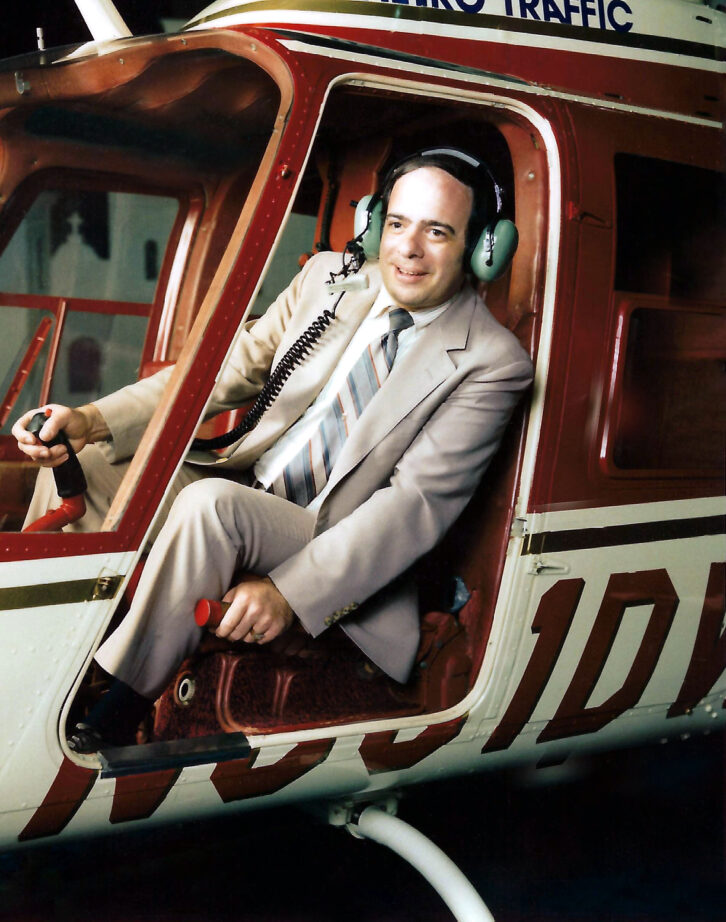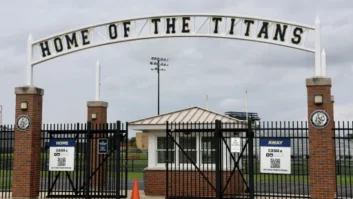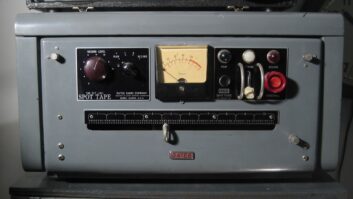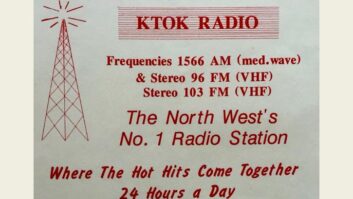Lowell Homburger, who marks 61 years in the broadcasting business this summer, says his first paying gig was “doing the all-night show at a daytime radio station.”
While that sounds like a joke, he actually did the 6 p.m. to sign-off shift on WXOX(AM) in Bay City, Mich. But like many radio people, Homburger had entered the world of media earlier. In 1956 he set up his own homemade station, called WBKS(AM) for “Bay City Ken Simons,” a reference to a neighborhood friend.
“Ken Simons’ father was director of communication for the local sheriff’s department, and he built a small radio transmitter for us that covered half of our community with a 200-foot antenna,” said Homburger.
“We ran our operation after school and we never interfered with other stations. My parents were in the jewelry business, but I never had the passion to look at that as a career. Speaking into a microphone and playing records seemed more fun to me.

“There were a lot of ways for boys to have fun in sports and other activities then, and I think having our own radio station kept us busy and out of trouble, while creating sort of a ‘You do that for fun?’ image among our friends.”
Homburger broadcast parades and other events from various locations by using local payphones, a microphone and a small mixer.
“We even had a banner for our station,” he said. “Local radio stations did a lot of remotes back then, and we couldn’t see why ours should be any different.”
When Simons, Homburger and their friend Russ McRae used the phone line at Simons’ house, they would occasionally run into complications.
“They had a party line and sometimes another person would try to make a call and we had to ask them to be patient because we were on the radio,” Homburger said.
“We even took a major network news feed right off the air from a distant FM station because no one listened to FM in the 1950s. We’d get discarded teletype stories from one of the radio news directors downtown who admired our desire to imitate the big guys. By the time we got it, the news was a little stale — but we had all the feature material we could handle.”

Still hard at work
When Homburger graduated to commercial radio, he held just about every position one could hold.
“That includes several summers I spent filling in at a market-leading Saginaw station for everyone on vacation. I learned to be a receptionist, prepare logs, write copy and handle all air shifts,” he said. “And I haven’t even mentioned filling in for the news and sports director.”
When Homburger started out, radio studio equipment was dominated by brand names like Gates, Ampex, Tapecaster and RCA. He marvels at how computer technology has changed the broadcast airchain.
“The sheer invention of today’s modern studios, without those famous logo faceplates … Who would have thought then that there could be a radio studio without any tape, without any records, and without any cartridge machines? On my first few weeks on the air, I thought cartridges were just the greatest invention.”

After years on the air, doing sales and sitting in the ownership seat at a number of stations in Saginaw-Bay City and Midland, he headed south, purchasing a last-place “beautiful music” FM station and AM simulcast in Phoenix, Ariz.
“I got to know Ernie Winn at TM pretty well over the years, and in 1977 ‘K104 FM’ became the first station in the country to launch TM’s ‘Beautiful Rock’ format. It was essentially a soft rocker. With only one other station in Phoenix with a similar sound, we became an overnight success,” he said.
“I was fortunate to have Phil Barry Baykian as my PD, and he did an awesome job. On the AM side, we duplicated the fun and excitement of Nationwide’s WGAR in Cleveland. We imported Phil Gardner, a mainstay in Cleveland, and had ‘Crazy Dave Otto’ as our morning guy, his first major-market job. He went on to a huge career success in Denver radio.

“The staffs of K104 and KQXE were such a tight bunch of pros. It has been 45 years since we all worked together and to this day, every few years they get together in Phoenix for a dinner and to celebrate the exciting times that radio used to provide to dedicated-radio-in-blood types.”
Homburger eventually retired from hands-on radio roles, except for voicing occasional spots. But he has continued to work with stations as a principal at Abernat, Roxben & Boggs, an acquisition management consulting firm in Charlotte, N.C. The staff reports that he still puts in 50-hour weeks.
At first, “I helped people acquire resources and methods to get into radio. I also helped those who’d ‘had it’ with ways to get out without sacrificing their hard-earned equity,” he said.
“In the last 25 years I have turned into a sort of ‘court of last resort’ for people who’ve run into difficult problems. I was able to facilitate ways and means for them to stay in the business and not lose their shirt.” Assisting AM stations in launching FM translators also has been a big part of his work.
And now Homburger is part of a team that’s building a new AM facility for EDI Media station KWRM in southern California. It will use a flared-skirt antenna developed by Ben Dawson of Hatfield & Dawson and Bobby Cox of Kintronic Labs.
“I grew up admiring the potential of AM and how easy it is to receive it on very simple radios. I felt that with the government and the FCC doing many things to advocate the preservation of AM, this could be a good example to set up a facility that is as technically progressive as the times allow and see what response it gets.”
Exhilaration

“The reasons I’m still interested in radio are twofold,” said Homburger. “First of all, I enjoy the interaction with broadcast professionals. Secondly, I really like the exhilaration of seeing people we guide succeeding and soaring in their entrepreneurial efforts.”
Homburger recognizes the rich history of radio prior to his arrival.
“The people who influenced me the most appreciated the magnificence of radio’s golden era in the 1930s and 1940s. They had orchestras, Art Deco buildings, large personalities, and they thought big,” said Homburger.
“Before the Telecommunications Act of 1996, these people were empire-building. They had radio in their blood and did everything by the book. They were devoted professionals who were admired community leaders.”
Homburger predicts that radio will still be an important part of people’s lives in 100 years.
“It has survived every type of competition and social trend that came and went. Where people listen and why they listen have changed, but good stations have figured out that a stream is as important as an RF signal. We are seeing a lot of big-market stations going local again. Radio will endure because stations can go through these changes and thrive. There’s no other medium that lets you drive a car while you’re being entertained. You can’t text or use social media while you drive.”
AM radio’s value could be seen when Hurricane Idalia went through Florida in 2023 and several FMs went off the air.
“When your power is out, TV is worthless too,” said Homburger, “and now I’m happy to see support in both houses of Congress for keeping AM in cars.”
He added, “The dynamics of going all-digital on AM are exciting to contemplate and give it parity with FM’s audio quality while capitalizing on AM’s longer signal range.”
But given news headlines about radio’s corporate debt problems and the decline of OTA revenue, is optimism appropriate?
“It is very simple,” he replies. “If you have something on the air that people want to hear, you will be successful. If you program ‘cookie cutter’ radio, with the only differentiation being a positioning liner or logo, you have lost the race.
“I am just appalled at so many of the heritage 50 kW blowtorches resorting to syndicated programming rather than programming they can create that influences audiences for both the daytime groundwave crowd and the nighttime skywave audience.” He is encouraged by efforts at stations like WJR Detroit and WBT Charlotte to build more programming around local personalities.
“Being a radio ‘star’ takes work, dedication and hours to perfect your craft. If you as an owner can create an air of creativity and let your air people try out to see if they have it takes, especially if you are a smaller market owner, some will soar and others will fall flat on their face.”
He encourages prospective station buyers to work with an experienced broker. “The other caveat I offer aspiring purchasers is to look at coverage including adjacent-channel FM reception issues. And don’t buy a fiscally successful station to help retire the debt when you overpaid for other stations in your portfolio. We all know what happens when that takes place.”
In the Homburger household radio is a team effort.
“Having a wife who may not understand the business is OK, as long as she understands the passion I have as part of my radio identity,” he said. “She tolerates the occasional delayed dinner because I’m helping a client out on a project that can’t wait until tomorrow. That’s my wife Amy, and she is a major part of my success.”
Any last words for Radio World, Mr. Homburger?
“One bit of advice I give all our clients,” he said. “For 2024 and beyond, it’s not your father’s broadcast world anymore, but it can be yours if you have the knowledge and take advantage of all the technical advancements the digital age has to offer. Combine that with the belief that radio is here to entertain listeners, and you can make it big in radio now and for a long time to come.”
Ken Deutsch is a former disc jockey and program director, but he says if he had been any good in those positions he’d still be in radio.







